Inside the Internet's Obsession with "Slime"
Strange, soothing—whatever you call it, millions of young women all over the world have been watching it, making it, and raking in money from it this year.

The pastel pink mass swelled and receded on my screen. Disembodied fingers poked and prodded it, resulting in loud pops and smacks. I watched as it was swirled and stretched and squeezed between well-manicured digits. It was all very satisfying.
Videos just like it have flooded Instagram in the past year—short clips of a female's hands (it is almost always a female) digging into tubs or discrete globs of colorful goo, mixing and sculpting the gelatinous concoction on loop. Something I and millions of other people with cell phones are apparently wont to spend hours watching.
By now, more than 4 million Instagram posts employ the hashtag "#slime." The tags "#slimerecipe" and "#slimetutorial" have each been invoked another 400,000-plus times. There are at least 50 accounts on the social media platform with the word "slime" right there in the handle—both @slimequeeens and @glitter.slimes have more than 1 million followers a piece, while @slimeysugar and @rad.slime are hovering around the 800,000 mark. The complete and total essence of these accounts: women's hands playing with endless variations of sparkly, shiny, stretchy goop.
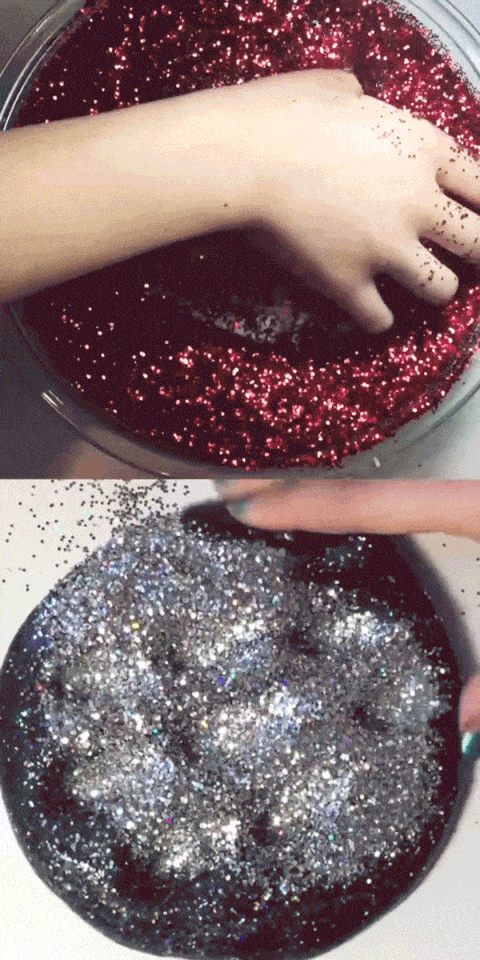
The trend is almost post-modern in its apparent pointlessness. I never would have guessed that I'd someday live in a world where it was normal to spend hours watching other people squish an inorganic substance (and I say this as a Millennial who grew up playing with Nickelodeon's Gak) but then again, what is normal anymore? Given that most of our lives are mediated by a screen—and that that screen spends a lot of time lately delivering nerve-frying, anxiety-inducing news—it makes sense that we would be drawn to the hyper-tactile, harmless, primordial nature of hands kneading goo.
Slime videos are said to likely trigger "ASMR"—Autonomous Sensory Meridian Response—which is a tingling sensation on the scalp from certain auditory, olfactory, or visual stimulation. The sensation was supposedly discovered by YouTubers who said they experienced noticeable relaxation when watching videos with sounds like whispering or brushing, or with repetitive visual patterns like laundry being folded. They describe the feeling as soothing and hypnotic.
Perhaps you learned of ASMR amidst the laundry list of other contemporary internet obsessions, trends, and subcultures: millennial pink, food porn, "unicorn" as an adjective to describe literally anything containing more than one shade of pastel. Slime intersects them all.
Craig Richard, PhD, professor of biopharmaceutical sciences at Shenandoah University, explains that the subtle sensory experiences elicited by ASMR videos likely create a sense of intimacy for viewers. "These videos relax us because we are hardwired to be soothed by people who can provide care to us," he says. Sounds like soft whispers, a paintbrush against paper, and—yes—fingers squishing into slime may engender feelings of personal attention, of being in an intimate environment. Richard posits that they likely activate our brains to release specific neurotransmitters and hormones that soothe us—possibly oxytocin, endorphins, dopamine, and serotonin.
Stay In The Know
Get exclusive access to fashion and beauty trends, hot-off-the-press celebrity news, and more.
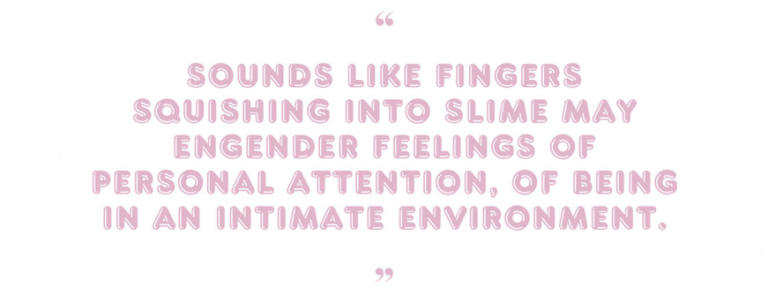
ASMR is the only digital trend that produces a sensation of pleasure in our physical bodies, so it's no wonder that new iterations of the phenomenon, like slime, are becoming phenomena themselves. It was just last summer that a handful of teenagers in Thailand started shooting YouTube tutorials on how to make the goopy mixture of water, food coloring, glue, and sodium borate (AKA Borax, a chemical used to kill cockroaches and other household pests). Many of those first YouTube slime accounts promised viewers an escape from boredom—the universal feeling that precipitates any deep dive into an internet rabbit hole.
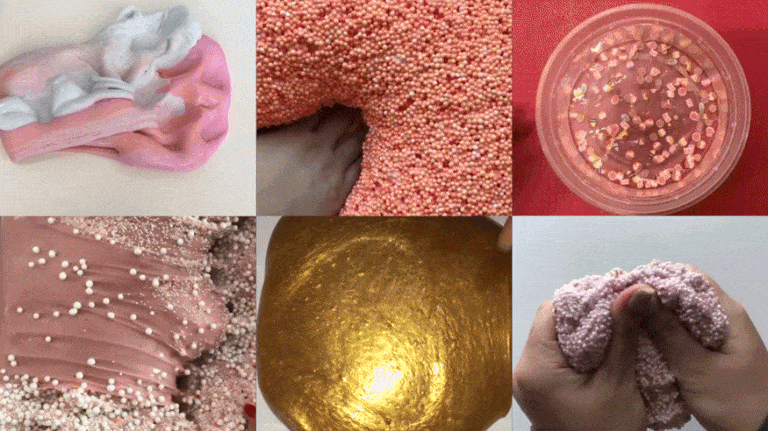
Over the past year, the slime community has imperialized islands across all corners of social media, from youth-crafting culture to mommy blogs to the Instagram feeds of Millennials like me, likely nostalgic for the days of Gak and other name-brand goo (see: Floam, Sqand, Goooze). Modern-day "slime" bears little resemblance to its '90s namesake, that green, viscous substance dumped on children during game shows—now it's more like a combination of pudding and Silly Putty. Some slime-makers add baby lotion and/or shaving cream to their recipes to adjust for silkiness and opacity. Then there are the requisite bonus ingredients: glitter, foam balls, confetti, tiny toy fish, even synthetic scents.
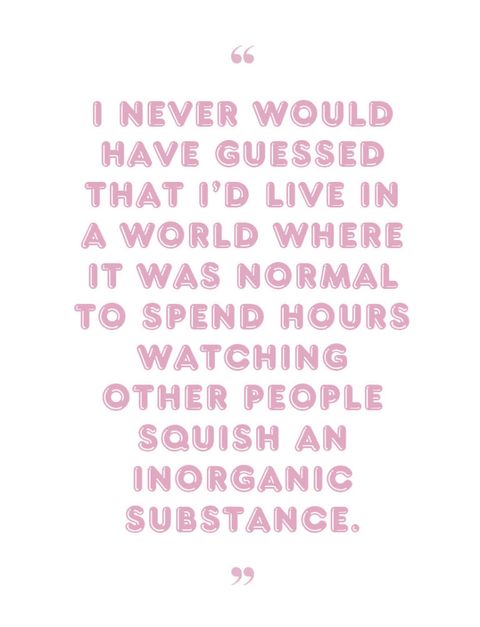
Of course the '90s references would be lost on the slime creators of today, many of whom are 13-year-old girls. But they're joined by an equally fervent fanbase of women old enough to be their moms. "I actually am a professional crafter," Trisha Haas, creator of the blog Mom Dot and frequent slimer, tells me. "My 12-year-old daughter and I recently authored a book on slime."
The market's primed. For all the millions of viewers watching slime get squished, there are plenty who want to squish it themselves. "Slime is my part-time job," says Alyssa Jagan, age 15, whose account @craftyslimecreator is approaching three-quarters of a million followers and who's sold more than a thousand containers of slime via her Etsy shop. "All the money I make selling my slime goes towards university or investing it back in to my business." Alyssa got her start making "goo" and "flubber" with her mom when she was a kid; when she saw DIY slime recipes spread across Pinterest last year, she was reminded of her childhood, and decided to make slime herself. She posted videos of her creations to Instagram and followers soon, well, followed. As a result of her Insta fame, Alyssa secured a book deal for a collection of Borax-free recipes called Ultimate Slime.
Thirteen-year-old Theresa Nguyen (@rad.slime) says she makes about $1,000 a week selling the slime she creates at her home in Texas, charging $10-13 per 6-oz container. She stocks her shop on Saturdays and "sells out later that day, or Sunday morning at the latest." Although slime supplies eat up about half of Theresa's weekly earnings, she's focused on the longterm: "I've been using the money to keep making more money and hopefully save up for college," she says.
But the trend is more than a marketing ploy, and maybe that's why it continues to grow—there's an earnestness to the approach. The owners of these accounts simply like slime, and fell into the business of selling it to other people who feel the same way. For 23-year-old Prim Pattanaporn of @sparklygoo, who has a book called The Zen of Slime out next month, slime is even a form of creative expression: "It's art," she says. "There are so many possibilities with art."
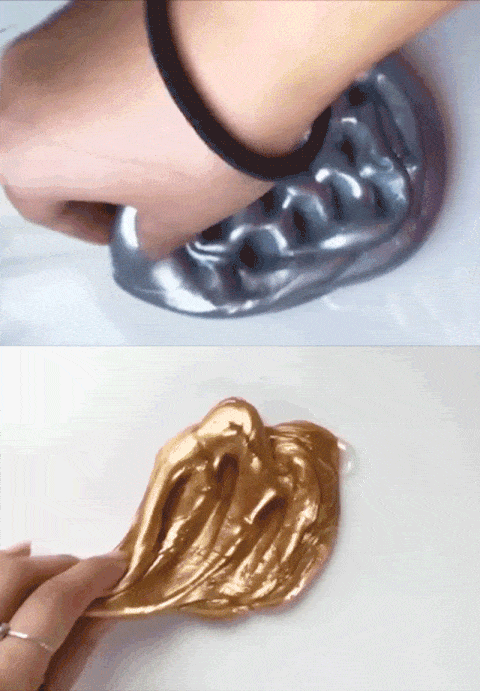
For some, the slime obsession is a little less...highbrow. "It's a mindless thing to scroll through while I should be doing other things and I've exhausted my feed," says 26-year-old Brooklynite Kate Weinreich, who got hooked on the trend via Instagram Discover. "It definitely satisfied some child-like fascination."
Whether our time-killing mindless scrolls are filled with slime videos or food porn, the irony's the same: We consume content that stimulates our brain's pleasure centers, but we never receive the satisfaction of the experience being portrayed. Several studies have indicated that merely looking at photographs of food makes us hungrier—but the photos certainly don't put the actual food in our mouths. Maybe the habit of the trance-like ogle is more about distracting ourselves just long enough to forget what's outside the periphery of the screen. "These videos bring viewers into a simple world," Richard, the ASMR researcher, says. "Or, as importantly, they remove them from a complex world."
There's another reason the food-porn comparison is apt: The food-like quality of slime may be simulating the survival instinct of discovering edible food. That's right, cynics, our love of slime may be evolutionary. "Our brains are hardwired to associate bright and rich colors with fruits, vegetables, and their flowers," Richard explains. "We evolved to respond to splashes of color because that might indicate, say, the presence of food in a forest." Perhaps we relax in the presence of slime because the survival state of finding comestibles—simulated by bright colors and squishy, chewing-like noises—is one of respite.
Whatever the science, there's something inherently comforting about stimuli that "get" to us on a deep, primitive level. Our screen-saturated culture is experiencing a crisis of physicality (it does not escape me that you are reading this on a screen), and maybe slime is its answer. What's making us feel a little more human right now might just be a lump of gloppy goo and a delicate hand, poking and prodding it.

Charlotte Lieberman is a Brooklyn-based writer whose work often concerns feminism, meditation, and mental health. You can read her articles in Cosmopolitan, The Harvard Business Review, BOMB,Teen Vogue, and Guernica, among other publications, and her poetry in The Boston Review, The Colorado Review, and Nat.Brut. Visit her at www.CharlotteLieberman.com.
-
 These Under-$200 Sandals Are Bound to Sell Out
These Under-$200 Sandals Are Bound to Sell OutIt's time to stock up.
By Lauren Tappan
-
 I Let Jennifer Lawrence Curate My Dream Sneaker Collection
I Let Jennifer Lawrence Curate My Dream Sneaker CollectionIf she wears a pair, I'm buying it.
By Julia Marzovilla
-
 What, You Haven't Showered In the Driest Place on Earth to Test Your Moisturizing Body Wash?
What, You Haven't Showered In the Driest Place on Earth to Test Your Moisturizing Body Wash?I traveled 4,500 miles to Altacama, Chile to put the 24-hour moisture claims to the test.
By Hannah Baxter
-
 The 100 Best Movies of All Time: The Ultimate Must-Watch Films
The 100 Best Movies of All Time: The Ultimate Must-Watch FilmsWe consider these essential viewing.
By Quinci LeGardye
-
 The Best Bollywood Movies of 2023 (So Far)
The Best Bollywood Movies of 2023 (So Far)Including one that just might fill the Riverdale-shaped hole in your heart.
By Andrea Park
-
 ‘Bachelor in Paradise’ 2023: Everything We Know
‘Bachelor in Paradise’ 2023: Everything We KnowCue up Mike Reno and Ann Wilson’s \201cAlmost Paradise."
By Andrea Park
-
 Who Is Gerry Turner, the ‘Golden Bachelor’?
Who Is Gerry Turner, the ‘Golden Bachelor’?The Indiana native is the first senior citizen to join Bachelor Nation.
By Andrea Park
-
 The 50 Best Movie Musicals of All Time
The 50 Best Movie Musicals of All TimeAll the dance numbers! All the show tunes!
By Amanda Mitchell
-
 'Ginny & Georgia' Season 2: Everything We Know
'Ginny & Georgia' Season 2: Everything We KnowNetflix owes us answers after that ending.
By Zoe Guy
-
 The Cast of 'The Crown' Season 5: Your Guide
The Cast of 'The Crown' Season 5: Your GuideFeatures The Mountbatten-Windsors have been recast—again.
By Andrea Park
-
 Who Is Hasnat Khan, Princess Diana’s Boyfriend on Season 5 of ‘The Crown’?
Who Is Hasnat Khan, Princess Diana’s Boyfriend on Season 5 of ‘The Crown’?Features Di’s friends have said she referred to the doctor as \201cthe love of her life.\201d
By Andrea Park